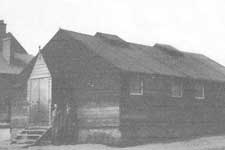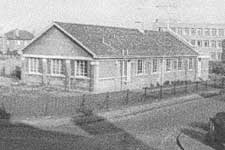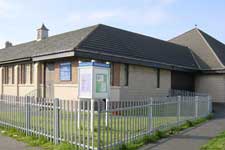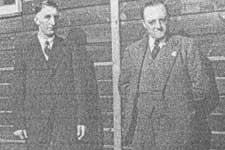Granton Baptist Church
Further information
On this page
Origins
In 1939, the District Women’s Auxiliary first planted the seeds for the church. At this time there was a growing population in the area with a lot of young families moving in. The group wanted to start up a Sunday School and Women’s Meeting and so wrote to the Baptist Union for their help. This was given without hesitation by the Baptist Union as Granton/Pilton was a prime area for outreach. A small but enthusiastic group met to organise the building of a church. The local authority, Edinburgh Corporation, had a few sites earmarked for granton_churches in the area. One of these – not the one originally identified – was obtained by Granton Baptist Church.
During the period from the conception to the actual opening of the new building there were meetings held each Sunday, and various groups during the week. These were in homes and other suitable locations.
So before the new church starting there was already a group of people to enter in as the first congregation. A Building Fund was formed to pay for the new church, which was one of many funds created over the years, and through donations and gifts the church was built.
Among the sources of funds for Granton Baptist Church was a contribution from Marshall Street Baptist Church, Edinburgh – the proceeds from the sale of the church building which closed in 1943. That church had been founded by Rev Francis Johnstone, and Granton Baptist Church was for a time referred to as ‘Francis Johnstone Memorial’. World War I memorial windows from the Marshall Street building are preserved in the present church at Granton.
Buildings
The church was opened as the ‘New Baptist Church Hall’ on the site of the present church in Crewe Road Gardens on 4 May 1940 in a wooden hut, which had possibly originally been a henhouse. Peter Bryan, the first minister, was inducted on 14 December 1940.
The cost of building the new church was largely covered by the proceeds of the sale of the Marshall Street Baptist Church, which was closed in 1943. The church was called the Francis Johnstone memorial in memory of Rev Francis Johnstone, in whose memory there is in the church a tablet which came from the Marshall Street Church.
The cost of the construction of the new building amounted to £12,000. The new building was opened on 20 December 1952. The stained glass windows are a memorial to those from the Marshall Street Church who died in action during World War I. The new church had seating for around 250, and there was a separate hall. There were a lot of problems with the new boiler house. The new building was erected adjacent to ‘The Hut’ which was rotated by 90 degrees.
A manse nearby in Grigor Gardens was purchased in 1958.
In 1961, it became apparent that ‘The Hut’ couldn't remain the same. It has served its purpose much longer that expected. A new hut or hall was needed to accommodate the further growth of the church. So a Hall fund was initiated. In January of 1971 saw a landmark for the church when there was an emotional farewell to "The Hut" which was then demolished to make way for the development of the new hall. This was opened on 24 March 1972. This building satisfied the needs of the church for the next twenty years. A bigger hall was built to hold 350 seats and still stands today.
The construction of the present church was begun in 1991 and the building was opened in 1992. It cost £375,000.
The present church building was opened and dedicated on 10 October 1992.
The 1952 building was named the McCallum Hall and the 1972 addition was named the Barnes Hall, both after former pastors.
Organisations
At the end of the 1940s the church had Lifeboys, a Young Worshippers League and the Band of Hope for children.
The women of the church sent 40 gifts of books and money to husbands, sons and daughters of church members serving in the forces during World War II.
The everyman’s meeting of the church had a cricket club, and they played at Silverknowes initially, but later played in a cricket ‘square’ in West Pilton Circus.
In 1954 the church had the following organisations:
- Brownies
- Girl Guides
- Cubs
- Scouts
- Junior CE
- Intermediate CE
- Junior Choir
- Junior Sunday School
- Junior Bible Class
- Senior Bible Class
In the late 1970s and early 1980s church camp tours took place in a number of locations in Scotland and at Berwick-upon- Tweed. In the 1980s and early 1990s there were church holiday weekends for adults and children to Biggar and Pitlochry.
In the mid 1990s adult baptisms took place for several years in the Forth at Silverknowes.
In 1989 the church conducted a ‘Pilton for Christ’ campaign in West Pilton Park in conjunction with the Old Kirk at West Pilton, the West Pilton Christian Centre and the Scripture Union.
Personalities
On 14 March 1941, 23 young people sat the Baptist Union Scripture Examination, after having endured a nine hour air raid alert the previous night. At the end of the exam there was another seven hour alert. On Sunday 29 September 1940 during the evening service in the church a bomb fell in Crewe Place about 400 yards away and two children were killed. The church was evacuated. There had apparently been no air raid warning. Robina Brown, the Sunday School secretary, was an air raid warden at the time and when there was an alert she went out with her steel helmet and gas mask. She lived at Tollcross and sometimes when the trams and buses stopped running during an air raid she had to walk to the church.
Over the years the women in the congregation did wonders in the running of the church, keeping everything spick and span as well as providing events to bolster up the funds of the church. They were the ones to arrange various functions and events to get money for the various funds. These included the Manse Fund, the Building Fund, the Missionary Fund and the General Fund. Over the years pastors have come and gone but each one has had their part to play in the growth of this church. The members too were faithful and committed to the church.
Mrs Ena Hall was the church organist from 1941 to 1980.



